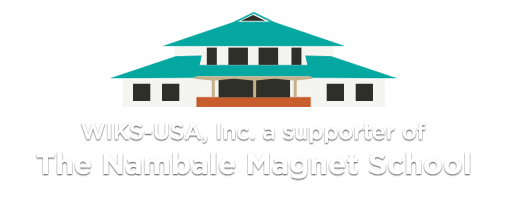Toward Sustainability
Toward Sustainability

Environmental Sustainability
As the school was being built, the contractors and architects used natural resources as efficiently as possible, keeping the carbon footprint to a minimum. This priority continues as the school expands with current systems that include:
- Water catchment system, which captures rainwater from building roofs and funnels it into cisterns for purification
- Solar LED security lights installed on the exterior walls of the school
- Biodigester to provide for responsible on-site sewage disposal, produce methane to supplement fuel used onsite and produce nutrient-rich fertilizer to be used in the School’s gardens.. The School would like to expand its use of biodigesters as funding permits

Agricultural Sustainability
Nambale Magnet School is able to produce many foods more cost-effectively than by purchasing them locally. The School has implemented many agricultural initiatives to produce healthy low-cost food for the students. When the students are on campus, this produce provides nutritious food for the students. When the students are on breaks, the produce is easily sold locally, generating a modest income stream.
- Gardens were developed in spring of 2009; they provide kale and other vegetables to enhance the children’s diet. Recently, Napier grass, a fodder crop for dairy animals, has been added
- Dairy Unit was built, two cows were purchased in July, 2010, several calves have been born; abundant milk is available for the students
- Greenhouse was built in November 2010 and provides vegetables year-round
- Poultry Unit was prepared in the spring of 2012, and soon after, laying hens were introduced to provide eggs for consumption at the school
- Pig Sty was completed early in 2013; piglets will grow quickly and (relatively) inexpensively, for sale locally
- Rabbit Hutch was built in March 2013; rabbits grow quickly and will provide another source of protein

Financial Sustainability
By the second year of operation, the Nambale Magnet School was attracting the children of families in the area able to pay school fees that go towards funding the marginal increased cost of their attendance. This ensures the social and economic diversity that makes the “magnet” concept so innovative in Kenya. It aligns the school’s mission with Kenyan government policy dictating that vulnerable or indigent children not be isolated from mainstream Kenyan culture.
The land and the current buildings are fully owned without debt.

Community Sustainability
Nambale Magnet School works to engage the community both locally and regionally, adding value to others beyond the student body.
The School provides gainful employment to a wide variety of local trades people and casual laborers who work on the School’s construction projects, landscaping and agricultural activities and who are employed as security guards, kitchen workers, laundresses and houseparents.
As part of the annual Founder’s Day observance, the children from the school work on a community service project in Nambale.
The school has been licensed to present Early Childhood Education seminars and training to area educators. These take place during school holidays and are a source of additional revenue for the school.
The school hopes to add Adult Education classes in subjects such as agricultural science and animal husbandry. Computer science classes will be offered if the school is able to acquire sufficient desktop computers. These will generate income and deepen the investment of the community in the success of the school.

Total Self-sustainability
Total self-sustainability is a long way off, but it continues to be closer and closer. Schools in the developed world build endowment funds to support the high cost of education, and provide tuition assistance to deserving students. Nambale Magnet School’s central mission is to house and educate children who have been orphaned or rendered indigent, and these students will require support from external sources for the foreseeable future. Yet the school has already taken large steps toward sustaining the population who lives there, preserving the environment, and developing initiatives that have the potential to generate income.

